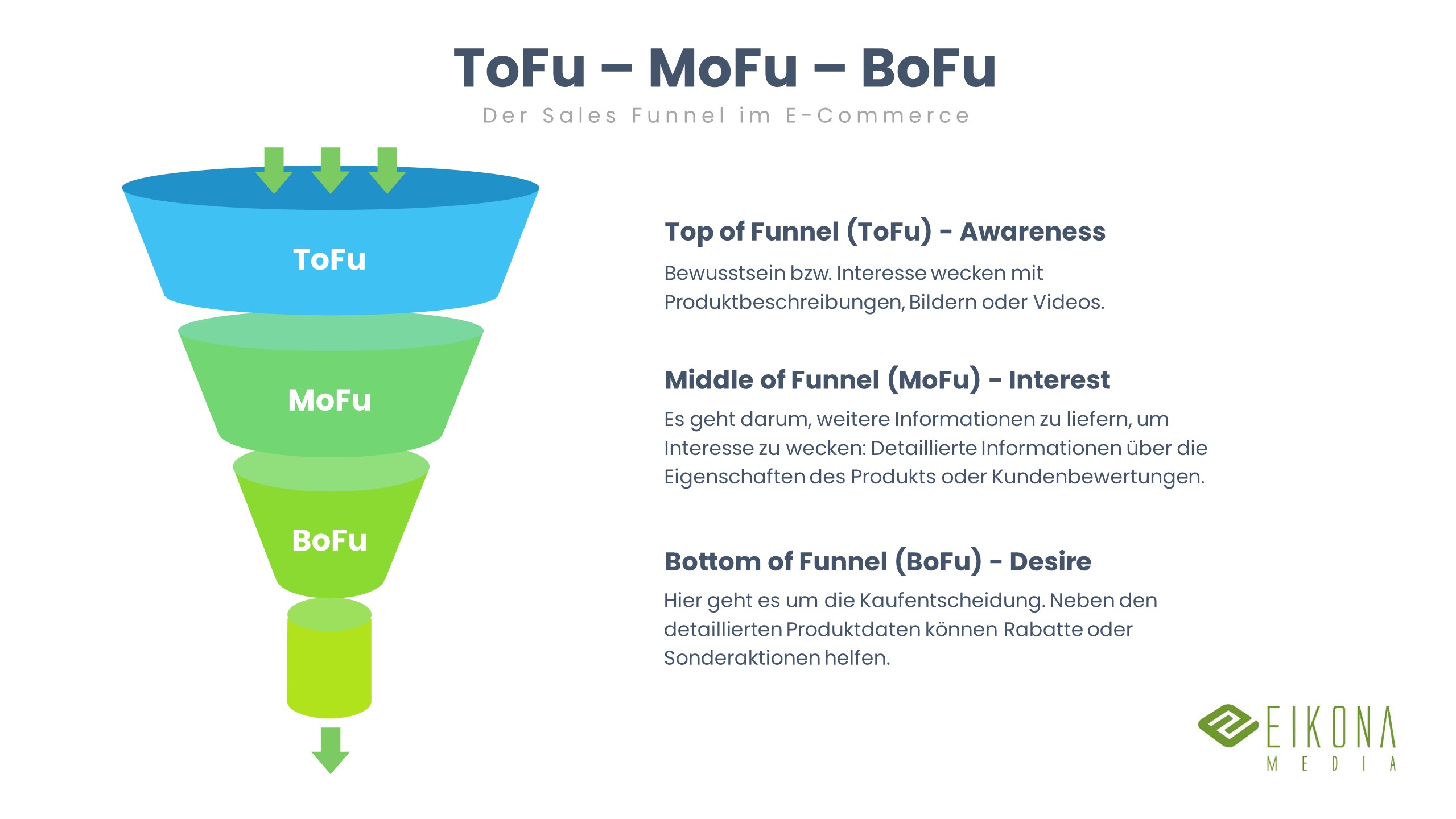The Sales Funnel in E-Commerce

Product data plays a central role in the E-Commerce Sales Funnel and is an essential part of the sales process. As more and more customers research online before making a purchase, it is crucial for businesses to provide relevant information in the ToFu, MoFu, and BoFu stages to convince potential customers.
What is a Sales Funnel?
In the current phase of digitization, optimizing sales strategies is becoming increasingly important for companies engaged in online product sales, known as E-Commerce. This is where the so-called Sales Funnel comes into play. But what does this term actually mean, and how does it work?
A Sales Funnel, also called a sales or purchase funnel, gets its name from the graphical representation used to depict it. It represents the sales process that a potential customer goes through until they become a paying customer. This funnel consists of several stages that the customer must go through sequentially. The number of stages can vary depending on the company and industry. Typically, a Sales Funnel includes three to four stages, which we will illustrate in the following paragraph:
-
Awareness: In this phase, the potential customer becomes aware of the company and its products. This can happen through social media campaigns or Google Ads, for example.
-
Interest: The customer shows interest in a product or service. They gather information on the company's website or search online shops for suitable offers.
-
Decision: The customer has chosen a product or service and is now in the decision-making phase.
-
Action: The customer makes the purchase of the product or service.
What areas are there in the E-Commerce Sales Funnel?
The Sales Funnel is a crucial component in E-Commerce, describing the journey a customer takes from the initial contact with a product to completing a purchase. Here, we explain the various phases and points where customer interactions occur.
Top of Funnel (ToFu) or Awareness
In the Top of Funnel phase, the focus is on raising the awareness of potential customers about the company and its products or services. Product data can contribute to capturing the interest of potential customers by providing detailed information about the product or service. Product data used in this phase may include, for example, product descriptions, images, or videos. These can be utilized on the company's website, on social media channels, or in advertising campaigns.
Middle of Funnel (MoFu) or Interest
In the Middle-of-Funnel phase, the potential customer expresses interest in the product or service. The goal here is to provide the customer with additional information to stimulate their interest and convince them of the quality of the offering. Product data that can be utilized in this phase includes, for example, detailed information about the product's features or customer reviews. Customer reviews are a powerful tool for gaining the trust of potential customers, as they demonstrate that other customers were satisfied with the product or service.
Bottom of Funnel (BoFu) or Desire
In der Bottom-of-Funnel-Phase hat der potenzielle Kunde bereits Interesse am Produkt oder der Dienstleistung gezeigt und ist bereit, eine Kaufentscheidung zu treffen. Hier geht es darum, den Kunden von der Kaufentscheidung zu überzeugen. Produktdaten, die in dieser Phase eingesetzt werden können, sind beispielsweise Rabatte oder Sonderaktionen. Diese können den Kunden dazu animieren, das Produkt oder die Dienstleistung zu kaufen.
OnSite
"OnSite" refers to the activities that take place on the company's own website. The goal here is to keep the potential customer on the website and encourage them to make a purchase. Product data that can be utilized in this phase plays a crucial role in creating an intuitive navigation, making it easier for the customer to find the product or service. Additionally, product data, assets, and the website's code should be written to ensure fast website loading times. A well-structured website—built on excellently structured product data—with clear call-to-actions can encourage the customer to purchase the product or service.
OffSite
"OffSite" refers to activities that take place outside the company's own website. The goal here is to engage potential customers on other platforms or channels and direct them to the company's website. Product data that can be used in this phase includes advertisements on social media platforms or collaborations with online shops that are supplied with product data. In both cases, product data serves as a relevant foundation. Targeted engagement on other platforms can help raise awareness of the company among potential customers and lead them to the company's website.
Product data plays a crucial role in the E-commerce Sales Funnel as it helps convince potential customers and provides them with relevant information. By strategically using their product data and tailoring it to the needs of potential customers, companies can ensure that they are addressing them effectively and providing relevant information. A well-optimized E-commerce Sales Funnel can contribute to customer retention and turning them into long-term customers. Therefore, companies should ensure that they continuously monitor and optimize their product data for success.
How are online marketing, performance marketing, and PIM (Product Information Management) connected in the sales funnel?
Various marketing activities play a crucial role in the sales funnel. Online marketing, performance marketing, and PIM are closely intertwined in this process.
Online-Marketing
Online marketing encompasses all measures conducted online to reach potential customers and typically direct them to a specific website. This includes activities such as search engine optimization (SEO), search engine advertising (SEA), email marketing, social media marketing, and display advertising.
Performance-Marketing
Performance marketing aims to improve the performance of a website or product through targeted advertising measures. Various metrics such as the conversion rate, revenue, or return on investment (ROI) are used for this purpose. Performance marketing includes activities such as affiliate marketing, display advertising, search engine advertising (SEA), and retargeting.
Product Information Management
PIM refers to the central management of product information. This includes, for example, product descriptions, various conceivable product attributes stored in individual attributes, images, videos, or technical data. An effective PIM strategy is of great importance for companies to inform customers about products in the best possible way and thus promote sales.
How are the measures in the sales funnel interconnected?
To successfully design the sales funnel, online marketing, performance marketing, and PIM need to be meaningfully linked. Online marketing measures aim to bring potential customers to the website and engage them with the offering. Through performance marketing measures, such as SEA or retargeting, the conversion rate can be increased, and revenue enhanced. An effective PIM strategy ensures that customers are comprehensively informed about the products, facilitating a purchase decision.
Conclusion
Holistic perspective required
Online marketing, performance marketing, and PIM are closely intertwined in the sales funnel. A successful sales strategy is only possible through a holistic consideration of these factors.

